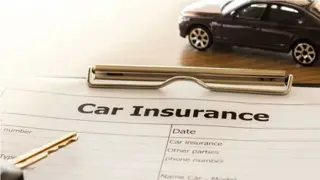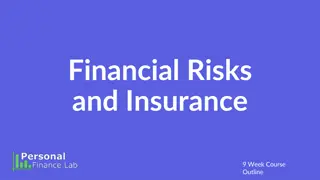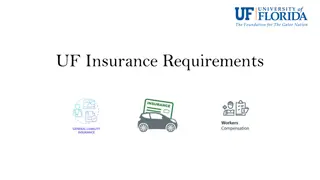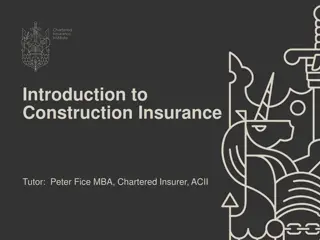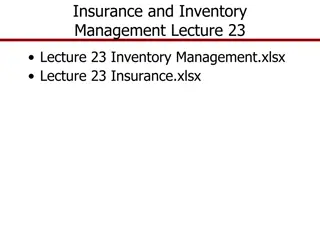Understanding the Basics of Insurance Risks
Explore the fundamentals of insurance risks, including the types of risks, insurability criteria, hazards, coverage examples, and concepts like self-insurance and reinsurance. Delve into insurer types, intermediaries, and different insurance structures to gain an in-depth understanding of the insurance industry.
Download Presentation

Please find below an Image/Link to download the presentation.
The content on the website is provided AS IS for your information and personal use only. It may not be sold, licensed, or shared on other websites without obtaining consent from the author. Download presentation by click this link. If you encounter any issues during the download, it is possible that the publisher has removed the file from their server.
E N D
Presentation Transcript
IF1 Workbook Lets discuss the exam structure To be a risk, a risk must have a possibility of a loss and unpredictability Can every risk be insured?
Chapter one Risks come in three pairs: Financial and non financial Pure and speculative Particular and fundamental
Chapter one To be insured risks must be: 1. Fortuitous 2. Have insurable interest 3.Not be against public policy
Chapter one What do we mean by the term law of large numbers What are homogeneous exposures What is meant by the common pool and pooling of risks What is meant by equitable premium
Chapter one What is meant by a peril What is meant by a hazard Hazards can be good or bad Hazards can be physical or moral
Chapter one Lets have a look at some risks and in each case lets run through the moral and physical hazards as well as the cover: Fire insurance for a factory Money insurance Glass insurance
Chapter one Moral and physical hazards for: Personal accident insurance Private medical insurance Critical Illness insurance
Chapter one Lets explore frequency and Severity What risks are high frequency low severity What risks are low frequency high severity
Chapter one What is self-insurance What is dual insurance What is co-insurance How does reinsurance differ from co-insurance How does a reinsurers customers differ from that of an Insurer
Chapter Two Different types of Insurer: Proprietary companies Mutual companies Captive companies
Chapter Two Intermediaries what do they do and who authorises them Insurance broker Lloyd s broker Appointed representatives (can include garages or vets) What is the difference between a consolidator and a broker network?
Chapter Two Main roles in insurance: Underwriter Claims personnel Loss adjuster Loss assessor Risk manager Actuary
Chapter Two Main market bodies ABI BIBA CII MIB UK Information Centre run the MID
Chapter Three Which hat does a broker wear? Agent of the Insured when placing cover or advising on cover or a claim Agent of the Insurer when collecting premium
Chapter Four Insurable interest arise in general insurance at For Life assurance it is For Marine cargo it is
Chapter Five Consumer Insurance Act 2012 States consumers have a duty not to misrepresent
Chapter Five Insurance Act 2015 States non consumer insureds have a duty to provide a fair presentation of risk Remedies are
Chapter Six Proximate cause is always the Lets consider Leyland shipping v Norwich Union 1918
Chapter Six Lets consider Marsden v City and County insurance 1865 What happens if a wall is left in a damaged condition following an impact
Chapter Seven What is meant by indemnity
Chapter Seven The four main ways of providing indemnity in the event of a claim are Cash Repair Replace Reinstate
Chapter Seven First Loss Policies
Chapter Seven Agreed value policies are a contract between ?
Chapter Seven Enterprise Act 2016
Chapter Eight Subrogation means the right of
Chapter Eight Contribution is used in the case of dual insurance
Chapter Nine Compulsory insurances Employers Liability Third Party Motor Public Liability for riding stables Professional Indemnity for solicitors and insurance brokers
Chapter Ten Regulation Financial Policy Committee Prudential Regulation Authority (PRA) Financial Conduct Authority (FCA)
Chapter Ten TCF is an example of principles based approach to legislation what do we mean by that? Six stages to TCF: Product design Identifying target markets Marketing and promoting Sales and advice After sales information including claims Complaint handling
Chapter Ten What do we mean by capital adequacy?
Chapter Ten Retail Mediation Activities Return (RMAR)
Chapter Ten Insurance Conduct of Business Sourcebook (ICBOS) FCA handbook covering:
Chapter Ten Money Laundering what is this? Three stages (PLi): Placement Layering Integration
Some statutes Chapters One/Nine/Ten Some statutes
Chapter Eleven Data Protection Act 2018 What is its purpose and to whom does it apply? What are the main data subjects rights? Two types of data Special characteristics and personal what is the difference?
Chapter Eleven What do we mean by the terms ethics? What do you think are the main points of the Cii code of ethics?
Chapter Eleven Training and Competence requirements what do these state? Are there specific qualifications
Chapter Eleven Financial Ombudsman Service (FOS)
Chapter Eleven Complaint procedures What is the FCA definition of a complaint?
Chapter Eleven Financial Services Compensation Scheme (FSCS) What is its purpose? What are the compensation limits?








